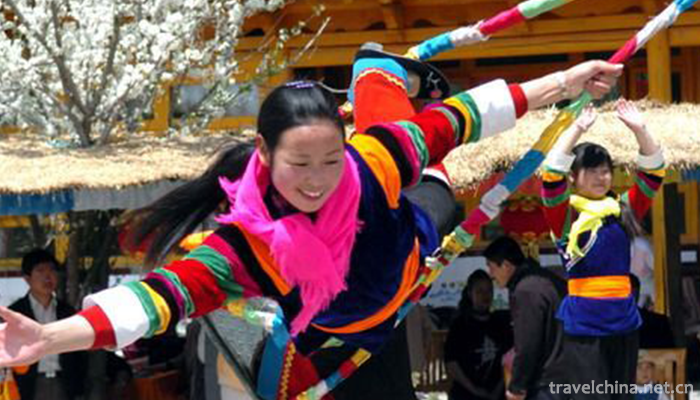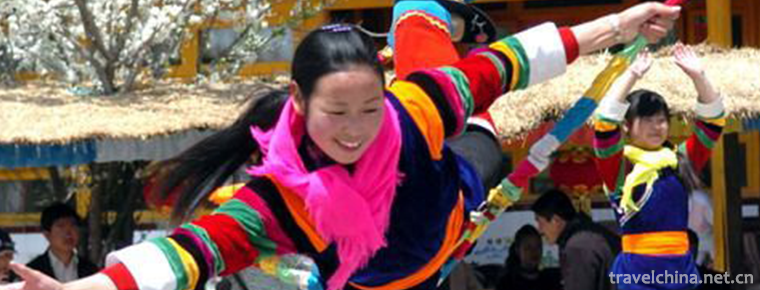Turkish Wheel Autumn
Turkish Wheel Autumn
There is a beautiful and magical legend about the origin of Tu's wheel autumn. Legend has it that in order to find a way out of life, the ancestors of the Tu nationality ploughed their fields successively with blue dragons and bison, and all of them failed. Finally, the cattle farmland was used to plough the South beach, plow the North Beach and sprinkle golden barley seeds. In autumn, wooden wagons are made to transport harvested crops. When the last cart of wheat bundles came on the stage, the car turned over and saw two belly-clearing dolls flying on the wheel of the sky, singing the harvest of the family song "Young Ge Er".
On June 7, 2008, the Tu wheels were listed in the second batch of national intangible cultural heritage list with the approval of the State Council.
historical origin
"Wheel Autumn" is a traditional entertainment of the Tus. Every year, after the busy farming in January, the Tu youths converted the boxcar into a crane with swings and turntables, and two girls in colorful clothes were flying and dancing on it. In order to be refreshing and refreshing for a year, it has become a custom for men, women and children to turn around on the wheel of autumn. Those who are skilled can also make difficult acrobatic movements.
Wheel autumn is the crystallization and symbol of the courage, wisdom and unity of the Tu people, and it is also a traditional activity that the Tu people, men, women, old and young, like to see and enthusiastically carry out.
Since then, every winter after the grinding field, people in the flat broad wheat field or spacious ground, unloading the shed of the car axles and wheels to stand up, to stabilize the center of gravity. A long wooden ladder is tied horizontally to an upward wheel. The two ends of the ladder are firmly tied to a rope loop made of epithelial or hemp ropes. They pushed the wooden ladder to rotate, then sat or stood in the rope circle with inertia, and quickly turned it, and performed various breathtaking and breathtaking action, which was applaudable. From time to time, the viewers helped push the wooden ladder to accelerate its rotation. Sometimes, a large group of young men and women in gorgeous clothes surround themselves in a circle, singing and dancing like stars and moons.
Performing methods
The wheel is made of wooden wheels of a large plate car. When moving, the axle is lifted down from the shed. The bottom fan is pressed onto the luxury block. The top fan is tied with a cross bar. The two ends of the cross bar are tied with a circle of epithelial ropes. The autumn beater sits in the rope ring and the wheel is rotated by the cross bar driven by others. In the past few years, the masses of Huzhu County improved the wheel autumn, using steel tubes as wheel discs, equipped with ball bearings, decorated with flags and ribbons, accompanied by Turkish music, together with Turkish Anzhao Dance, which became a quite distinctive national performance project.
Protection status
Turkish Wheel Autumn is listed as one of the national intangible cultural heritage lists in June 2008. In Huzhu Tu Autonomous County of Qinghai Province, women and children are well known as long as wheel autumn is mentioned. The Tu people of Mutual Aid like the traditional national sports activities of Wheel Autumn, and the performance of Wheel Autumn has won many honors for the Tu people of Mutual Aid with its strong local and national characteristics.
Folklore Situation
Tu Wheel Autumn is mainly popular in the area of Tu Autonomous County. In the past, during the leisure season, especially during the Spring Festival, people often unloaded the "upper foot" (shed) of the horse-drawn cart, and erected the "lower foot" (wheels and axles) as a whole, pressed stones and other heavy objects on the wheels touching the ground, maintained the stability and balance of the center of gravity, and tied a ladder three or four meters long horizontally on the wheels above, with a "U" (swing) seat cover at each end of the ladder. In the competition, each two people sits on the swing set, and then rotates the wheel vigorously, wins by spinning for a long time without dizziness and blindness. It is a popular sport and entertainment for men, women and children, especially for teenagers. Later, the Turkish people continued to improve the wheel autumn. Wheels are welded from steel pipes and equipped with ball bearings, which is more scientific and more safe and convenient to use. In recent years, Lunzi Autumn has been listed as a performance or competition item in the National Peasant Games and National Games, which has renewed the vitality of the ancient sports and entertainment activities of the Turkish people.


-
1.Eastern Royal Tombs of the Qing Dynasty
Eastern Royal Tombs of the Qing Dynasty is located 30 kilometers northwest of Zunhua City, Tangshan City, Hebei Province. It is 125 kilometers west of Beijing City and covers an area of 80 square kil
Time 2018-11-24 -
2.Beef bun on pot
Beef bun on pot/Beef frying bag is a home-cooked delicacy. It is made of beef as the main ingredient and salt as the auxiliary ingredient. Among them, the most famous and authentic is Yongcheng specia
Time 2018-11-26 -
3.Mingsha Mountain Crescent Spring Scenic Area
Mingsha Mountain Crescent Spring Scenic Spot is located 5 kilometers south of Dunhuang City, Gansu Province. It covers an area of 312,000 square kilometers
Time 2018-12-12 -
4.Kizil Gaha Peak Sui
Located on the east side of Saltwater Valley in the northwest of Kuqa County Town, Kizil Mahabi is a towering ancient military building with the meaning of "old red mouth" or "red sentr
Time 2018-12-23 -
5.GUI Opera
Gui Opera (commonly known as Gui Opera or Gui Ban Opera), Guangxi local traditional drama, one of the national intangible cultural heritage.
Time 2019-05-02 -
6.Dough Flowers
Flower, commonly known as "flower bun", belongs to the art of facial sculpture. There are weddings, funerals, birthday gifts, Festival buns. Flowers are made of ordinary flour and special fl
Time 2019-06-05 -
7.Machirev
Machirev is a name for a form of dance and entertainment, which refers to a large-scale self-entertainment activity with a large number of participants (the so-called participation refers to those who
Time 2019-07-06 -
8.Yingge Liushu
Yingge Liushu, also known as Yingge Liuzi, is a traditional art form of rap and singing spread in southwestern Shandong, southern Shandong, Eastern Henan and Northern Jiangsu. Legend has it that the L
Time 2019-07-14 -
9.Zhang Jia Agui
Ah Kui (September 7, 1717 - October 10, 1797). Zhang Jiashi , word Guang Ting , Number Cloud cliffs Manchuria's blue flag people (after the war in Xinjiang were promoted to Zheng Bai Qi), a Bachelor o
Time 2019-09-11 -
10.Bowang mountain
Bo (B ó) Wang mountain, also known as Bowang mountain. Bowang mountain is one of the most important breeding and living places of the ancient Bo nationality. It was known as lunzhudadun and shitoudazhai in ancient times
Time 2020-10-16 -
11.Leshan water resources
There are many rivers in Leshan City, including Minjiang River, Dadu River, Qingyi River and many small and medium-sized rivers. It is a water rich area with an average annual water production of 11.37 billion cubic meters. With 74.14 billion cubic meters
Time 2020-12-17